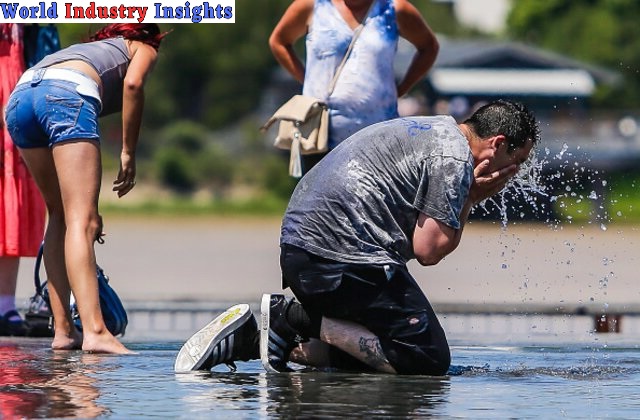America Heatwave Crisis: As a relentless and record-breaking heat wave sweeps through the nation, American businesses find themselves in the grip of its scorching fury. The blazing heat is inflicting its toll on cities like Phoenix, Arizona, and Holtville, California, while even craft breweries across the country are not immune to its effects. With the summer desert heat arriving earlier, intensifying, and lingering longer, entrepreneurs, workers, and industries are left scrambling to cope with the staggering economic impact of this heatwave.
Lyn Thomas, a tenacious business owner, runs Zydeco’s Louisiana Kitchen Food Truck and 2 Geaux walk-up window, delighting customers with authentic Cajun and Creole delicacies from generations-old recipes. However, the searing temperatures in Phoenix have forced her to reevaluate her business approach. With 23 consecutive days witnessing temperatures above 110 degrees Fahrenheit, Thomas can no longer park her food truck and wait for customers. Instead, she has shifted to catering to alleviate the harsh weather’s burden.
The full extent of the economic repercussions remains unknown, but projections suggest that extreme heat could exact a staggering cost of $100 billion per year in productivity losses for the United States. Left unchecked, this scorching phenomenon could erode one-sixth of global economic activity by the year 2100.
Outdoor workers bear the brunt as temperatures soar. Industries like agriculture and construction, where workers toil under the scorching sun, experience reduced productivity due to heat-related stress. Heat-induced illnesses and cognitive impairment become prevalent, prompting employers to step in by providing ice, water, shade, and flexible working hours during peak heat to safeguard their workforce.
For individuals like Jack Vessey, a fourth-generation farmer in Holtville, Imperial County, the heat is a familiar adversary. His family’s produce grower and shipper, Vessey & Company, adheres to state heat illness prevention regulations to protect its nearly 100 employees. As they prepare the fields for planting, they diligently monitor the labor force and provide essential resources such as ice, water, and shade.
Yet, the risk of heat stress often goes overlooked, especially among young workers who feel invincible. Kathy Baughman McLeod, Director of the Adrienne Arsht-Rockefeller Foundation Resilience Center, emphasizes the need to raise awareness of this silent, invisible threat. While heatwave naming and health-based warning systems aid in safeguarding workers, the lack of national heat-specific worker protection regulations remains a cause for concern.
Read More: Taylor Swift The Mesmerizing Impact of Taylornomics on Cities and Economies”
Businesses working with animals are not spared either, taking proactive measures to shield their creatures from the sweltering heat. Harrold Granthan, who runs the Broken Saddle Riding Company in Los Cerrillos, New Mexico, limits horseback riding to the cooler mornings and evenings during summer. Providing shade, water, and frozen treats like bloodsicles and fishsicles (made from blood and fish, respectively), helps horses cope with the soaring temperatures.
For major attractions like the Phoenix Zoo, the focus shifts to safeguarding animals, visitors, and staff during extreme heat. Bonnie Mendoza, the zoo’s COO and CFO, describes the extensive measures taken, including providing animal habitats with pools, shade, and heat-fighting treats. To protect humans, the zoo offers free tram services, ample water, and diligent cooling system maintenance.
Craft breweries, integral to American culture, have not escaped the heatwave’s grasp. Arizona Wilderness Brewing, reliant on patio sales for 60% of its revenue, experienced a drop in sales since the pandemic, further exacerbated by the relentless heat. As brewing requires precise temperatures, cooling systems become indispensable for both employees and beer production. The extreme weather also delays the harvesting of the popular seasonal watermelon Gose beer.
As the heatwave persists and intensifies, businesses and the economy at large are set to grapple with mounting challenges. Economist Joshua Graff Zivin of the University of California San Diego warns of the potential decline in working hours and output, which may cause small quarterly GDP dips an unprecedented situation in modern US history. In response, industries, governments, and communities must unite, forging long-term solutions, implementing heat-resilient strategies, and diligently protecting businesses and their employees.
In conclusion, the heatwave has left an indelible scar on American businesses, exposing vulnerabilities and compelling them to adapt to the new normal. Despite the economic damage already incurred, it is not too late to take action. Industries and the economy must brace themselves for escalating heat events as temperatures continue to rise. Coping strategies, regulation, and heightened awareness are the keys to survival in the face of this relentless heatwave.
Our Reader’s Queries
What is causing the US heat wave?
The burning of fossil fuels has led to a significant increase in greenhouse gases, which in turn has caused climate change. This change is expected to result in longer, more intense, and more frequent heat waves. It is crucial that we take action to reduce our reliance on fossil fuels and adopt more sustainable practices to mitigate the impact of climate change.
Is 2024 going to be hotter than 2023?
According to Andrew Dessler, a climate scientist at Texas A&M University, 2024 is expected to be hotter than 2023 if things follow the usual trend. However, he also notes that the “normal pattern” may no longer exist. Regardless, 2024 is predicted to be one of the hottest years on record.
What is causing 2023 heat wave?
Heat waves have been linked to human-induced climate change by scientists. Additionally, the El Niño phenomenon, which started to form in 2023, is another contributing factor. However, recent research indicates that climate change is intensifying the potency of El Niño.
Is 2023 the hottest year on record?
In 2023, we witnessed a historic rise in temperatures. It was not just the warmest year on record, but also the first year where every single day was over 1°C warmer than the pre-industrial era. This alarming trend highlights the urgent need for us to take action against climate change. We must work together to reduce our carbon footprint and protect our planet for future generations.


